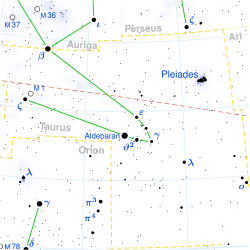- Epsilon Tauri
-
Epsilon Tauri Observation data
Epoch J2000 Equinox J2000Constellation Taurus Right ascension 04h 28m 37.00s [1] Declination +19° 10′ 49.5″ [1] Apparent magnitude (V) +3.53 Characteristics Spectral type K0III B−V color index 1.014 Astrometry Proper motion (μ) RA: 106.19 ± 0.38 [1] mas/yr
Dec.: -37.84 ± 0.30 [1] mas/yrParallax (π) 22.24 ± 0.25[1] mas Distance 147 ± 2 ly
(45 ± 0.5 pc)Details Mass 2.7 ± 0.1 M☉ Radius 12.692 ± 0.545 [2] R☉ Luminosity 97 ± 8[3] L☉ Temperature 4901 ± 20 K Metallicity +0.17 ± 0.04 Age 625 × 106 years Other designations Epsilon Tauri (ε Tau, ε Tauri) is an orange giant star, spectral type of K0 III, located approximately 147 light-years[1] away from the Sun in the constellation of Taurus. It is a member of the Hyades open cluster. It has the traditional names Ain (Arabic عين), or Oculus Borealis, both of which mean "eye".
It has an 11th magnitude companion 182 arcseconds from the primary.
Since Epsilon Tauri lies near the plane of the ecliptic, it is sometimes occulted by the Moon and (very rarely) by planets.
As a member of the Hyades cluster, Epsilon Tauri's age is well constrained at 625 million years.[3] Given its large mass, this star was formerly a member of spectral type A that has now evolved off the main sequence into the giant phase. It is regarded as a red clump giant that burns helium at its core.
Planetary system
In 2007 a massive extrasolar planet was reported orbiting the star. The planet orbits Epsilon Tauri every 1.6 years in a somewhat eccentric orbit. At the time of the discovery it was the only known planet in an open cluster.[4] No other planets have yet been detected in the Hyades cluster, but another planetary system—Iota Horologii— belongs to the Hyades stream and may be an escaped member of the cluster.
The Epsilon Tauri system[3] Companion
(in order from star)Mass Semimajor axis
(AU)Orbital period
(days)Eccentricity b >7.6 (± 0.2) MJ 1.93 (± 0.03) 594.9 (± 5.3) 0.151 (± 0.023) References
- ^ a b c d e f van Leeuwen, F. (2007). "HIP 20889". Hipparcos, the New Reduction. http://webviz.u-strasbg.fr/viz-bin/VizieR-5?-out.add=.&-source=I/311/hip2&recno=20836. Retrieved 2009-12-08.
- ^ Gerard T. van Belle and Kaspar von Braun (2009). "Directly Determined Linear Radii and Effective Temperatures of Exoplanet Host Stars" (abstract). The Astrophysical Journal 694 (2): 1085–1098. Bibcode 2009ApJ...694.1085V. doi:10.1088/0004-637X/694/2/1085. http://www.iop.org/EJ/abstract/0004-637X/694/2/1085/.(web Preprint)
- ^ a b c Sato et al.; Izumiura, Hideyuki; Toyota, Eri; Kambe, Eiji; Takeda, Yoichi; Masuda, Seiji; Omiya, Masashi; Murata, Daisuke et al. (2007). "A Planetary Companion to the Hyades Giant ε Tauri". The Astrophysical Journal 661 (1): 527–531. Bibcode 2007ApJ...661..527S. doi:10.1086/513503. http://www.iop.org/EJ/article/0004-637X/661/1/527/21184.html.
- ^ "Notes for star eps Tau". The Extrasolar Planets Encyclopaedia. http://exoplanet.eu/star.php?st=eps+Tau. Retrieved 2007-02-09.
External links
- "Notes for star eps Tau". The Extrasolar Planets Encyclopaedia. http://exoplanet.eu/star.php?st=eps+Tau. Retrieved 2008-06-24.
- "Star Names". Frosty Drew Observatory. http://www.frostydrew.org/observatory/columns/essays/starnames.htm. Retrieved 2008-06-24.
Coordinates: 04h 28m 37.0s, +19° 10′ 49″
04h 28m 37.0s, +19° 10′ 49″Bayer - α (Aldebaran)
- β (Elnath)
- γ (Prima Hyadum)
- δ¹ (Secunda Hyadum)
- δ²
- δ³
- ε (Ain)
- ζ (Tien Kwan)
- η (Alcyone)
- θ¹
- θ²
- ι
- κ¹
- κ²
- λ
- μ
- ν
- ξ
- ο
- π
- ρ
- σ¹
- σ²
- τ
- υ
- φ
- χ
- ψ
- ω¹
- ω²
- b
- c
- d
- e
- f
- h
- i
- k
- l
- m
- n
- o
- p
- q (Taygeta)
- r
- s
- t
- u
- A¹
- A²
Flamsteed - 1 (ο)
- 2 (ξ)
- 4 (s)
- 5 (f)
- 6 (t)
- 7
- 9
- 10
- 11
- 12
- 13
- 14
- 16 (Celaeno)
- 17 (Electra)
- 18
- 19 (q, Taygeta)
- 20 (Maia)
- 21 (Asterope I)
- 22 (Asterope II)
- 23 (Merope)
- 24
- 25 (η, Alcyone)
- 26
- 27 (Atlas)
- 28 (Pleione)
- 29 (u)
- 30 (e)
- 31
- 32
- 33
- 35 (λ)
- 36
- 37 (A¹)
- 38 (ν)
- 39 (A²)
- 40
- 41
- 42 (ψ)
- 43 (ω¹)
- 44 (p)
- 45
- 46
- 47
- 48
- 49 (μ)
- 50 (ω²)
- 51
- 52 (φ)
- 53
- 54 (γ, Prima Hyadum)
- 55
- 56
- 57 (h)
- 58
- 59 (χ)
- 60
- 61 (δ¹, Secunda Hyadum)
- 62
- 63
- 64 (δ²)
- 65 (κ¹)
- 66 (r)
- 67 (κ²)
- 68 (δ³)
- 69 (υ)
- 70
- 71
- 72
- 73 (π)
- 74 (ε, Ain)
- 75
- 76
- 77 (θ¹)
- 78 (θ²)
- 79 (b)
- 80
- 81
- 83
- 84
- 85
- 86 (ρ)
- 87 (α, Aldebaran)
- 88 (d)
- 89
- 90 (c¹)
- 91 (σ¹)
- 92 (σ²)
- 93
- 94 (τ)
- 95
- 96
- 97 (i)
- 98 (k)
- 99
- 101
- 102 (ι)
- 103
- 104 (m)
- 105
- 106 (l)
- 107
- 108
- 109 (n)
- 110
- 111
- 112 (β, Elnath)
- 113
- 114 (o)
- 115
- 116
- 117
- 118
- 119
- 120
- 121
- 122
- 123 (ζ, Tien Kwan)
- 125
- 126
- 127
- 128
- 129
- 130
- 131
- 132
- 133
- 134
- 135
- 136
- 137
- 139
- 140
- 44 Eri
- 49 Eri
Nearby - WISE 0410+1502
- Gliese 176
Other Categories:- Bayer objects
- Binary stars
- Flamsteed objects
- Hyades cluster
- Taurus constellation
- K-type giants
- Stars with proper names
- Planetary systems
Wikimedia Foundation. 2010.

